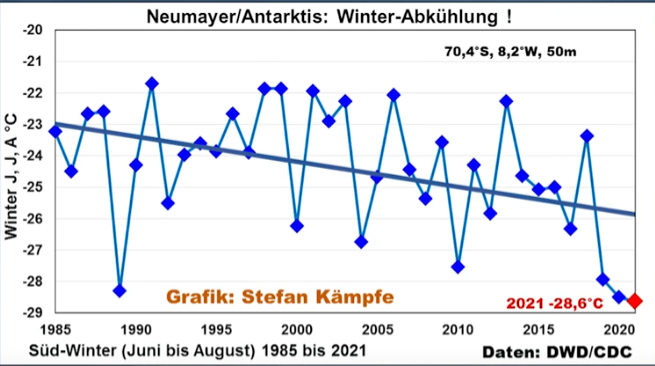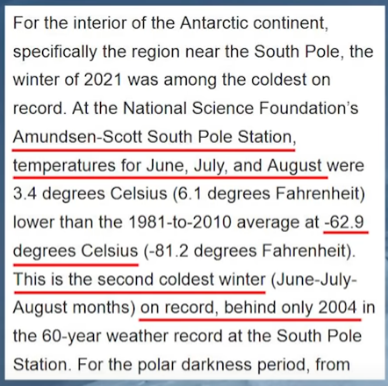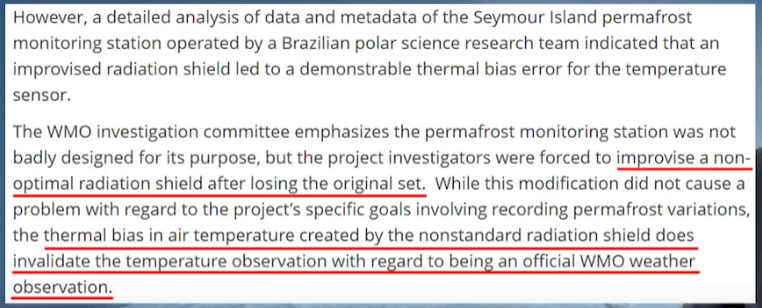Antarctica sets a record cold six month period…Neumayer station sets new winter record low, sees rapid cooling since 2000!
German Die kalte Sonne here features Antarctica’s record cold winter – the coldest since temperature measurements began some 60 years ago.
Coldest April-September period
The Amundsen Scott station at the South Pole recorded a mean temperature of -60.9°C for the April 1 to September 30 period, according to the US National Snow and Ice Data Center (NSIDC). For the June-July-August period, the mean was minus 62.9°C — the second coldest recorded.
Image: Die kalte Sonne.
Apparently the 140 or so ppm added CO2 couldn’t trap enough heat to prevent a record cold from being set. The previous record for June-July-August was set in 2004.
Neumayer sets record cold, sees 3°C of cooling since 1985
Die kalte Sonne reports that a record was also set at the German Neumayer Antarctic station, located on the Antarctic coast, which saw a mean June-July-August temperature of -28.6°C.
Recording at the Neumayer station began in 1985, and the linear trend over the past 35 years has fallen by almost 3°C! It’s been cooling even faster since 2000:
 Rapidly cooling Antarctic. Chart: Stephan Kämpfe. Data: DWD.
Rapidly cooling Antarctic. Chart: Stephan Kämpfe. Data: DWD.
The German Neumayer Antarctic station has seen a distinct cooling trend since 1985, according to data from the German DWD national weather service. This is not getting reported by the media in Germany in any way, shape or form. We can just imagine the blaring headlines if the trend instead had shown 3°C of warming. You’d have a thousand German journalists descending on the South Pole by now.
Record warm reading gets discarded
Last February, for example, the German Berliner Morgenpost reported how for the first time the temperature had climbed over 20°C at the northern tip of the Antarctic peninsula – Seymour Island. “At the South Pole, climate change is very clear,” declared the Morgenpost.
However a subsequent World Meteorological Organization (WMO) investigation found the reading had in fact nothing to do with climate change, Die kalte Sonne reports:
Image: Die kalte Sonne.
The 20.75°C “record” reading resulted from a faulty instrument, and thus was nullified last July.
Yet, activist groups like Germany’s DUH don’t want to hear any of it. They continue to cite the nullified record even today for gathering petition signatures.







Antarctica is the perfect natural control for isolating the impact of CO2 on temperatures. There is no Urban Heat Island Effect, No water Vapor, level Albedo and relatively isolated from any other major factor that could alter the temperatures. It is a natural laboratory to testing the impact of CO2 on temperatures. CO2 has increased at the same rate over Antarctica as everywhere else and it has resulted in 0.00 warming.
Consensus does not allow debate, that is what it is for.
Only one side of the issues gets reported.
Interestingly, Anthropogenic Global Warming (AGW) theory predicts faster warming in the polar regions… How embarrassing!
I bet none of the pompous idiots convened in Glasgow get the fact that AGW is dead, and we now have an alternative theory (Svensmark & Shaviv) that’s been proven to work in the real world.
CO2isLife: The Earth’s dominant infrared-radiation-active gas is of course water vapor, by 29:1 according to Lightfoot & Mamer — from 97:1 in the tropics to 1:1 at the poles. That makes Antarctica the likeliest place for CO2 to have a measurable radiative effect.
(See Lightfoot, H.D., and O.A. Mamer, “Back radiation versus CO2 as the cause of climate change,” Energy & Environment 2017. DOI: 10.1177/0958305X17722790, journals.sagepub.com/¬home/ese.)
That makes it even more unlikely to have any effect when water vapor is present.
[…] From the NoTricksZone […]
The only measurable human influence on the weather (not climate) is the Urban Heat Island effect. The only measurable human influence on the climate is air pollution, mainly dustparticles. As the reduction of human dust particle production is a doable technological enterprise through more innovative production technologies, the road to this problem solution is clear: decentralised nuclear power generation. What took us so long????
[…] From the NoTricksZone […]
[…] From the NoTricksZone […]
yet every global average has Antarctica as one of the fastest warming areas on the planet, So those averages are all wrong.
Sorry to hear that! Perhaps, after 45 years as an astronomer, and after 10 years of studies about climate, I have always done wrong calculations and also looked at the wrong observational data. Actually one can never be totally sure about what he has understood during his life. So, thank you so much for your very valuable information.
Surely if Trenberth et al are correct (as if it isn’t alarmism) then 83% of the IR emitted to space comes from “greenhouse gases” then why would larger amounts not facilitate a higher IR radiation level to space as is self evident in all the satellite data ?
[…] Fonte: No Tricks Zone […]